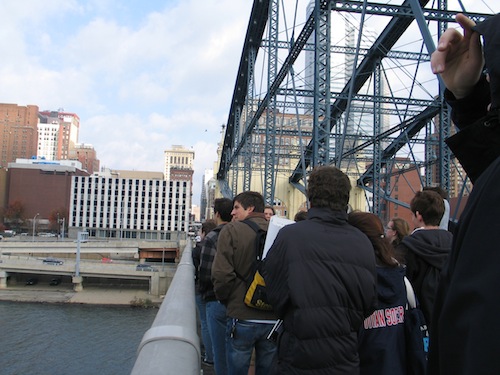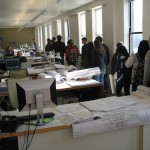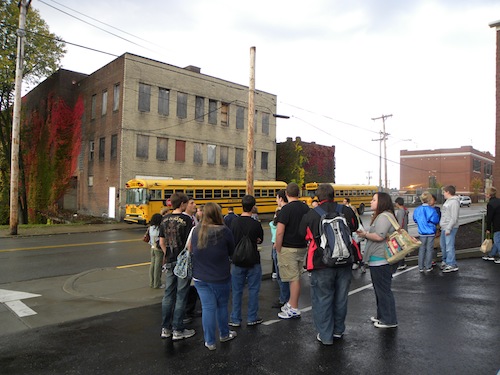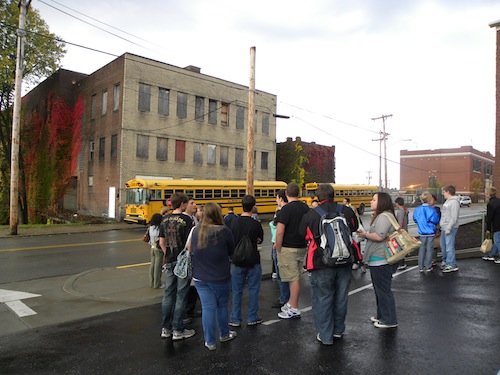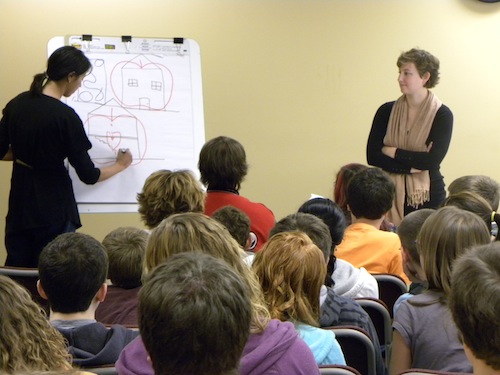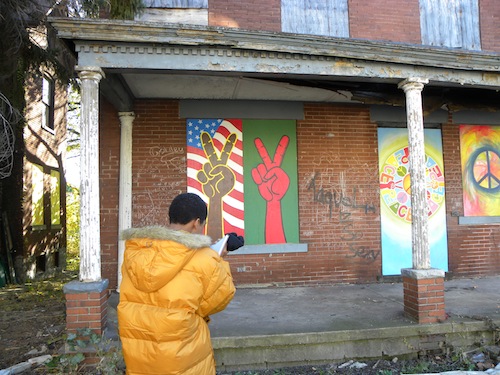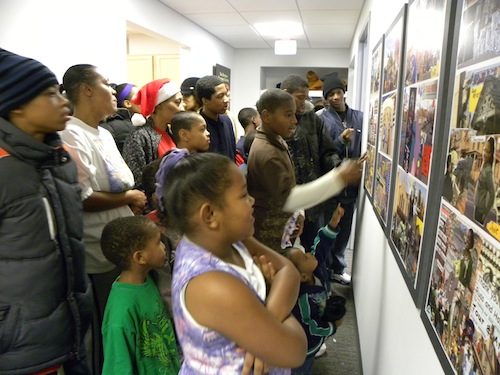
Category Archive: Preservation News
-
Golden Triangle Buildings Could Get Face-Lifts
Sunday, December 26, 2010
By Mark Belko, Pittsburgh Post-GazetteThe city is looking to brighten up some “dark corners” Downtown.
Aided by a $4 million state redevelopment assistance grant, the Urban Redevelopment Authority hopes to target rundown buildings Downtown and work with property owners to upgrade them.
The project is designed to supplement a larger revitalization in the Golden Triangle that already has included the construction of the Three PNC Plaza office tower and the redevelopment of a former five-and-dime store and a department store into residential, retail and other uses.
With much of that work completed, the URA has decided to go after properties “in need of some reinvestment” — not to buy but to approach and work with the owners about making improvements.
“This is really a building-by-building, block-by-block approach,” said Yarone Zober, URA board chairman and chief of staff to Mayor Luke Ravenstahl.
Mr. Zober said the genesis for the idea came during walks he and Mr. Ravenstahl had Downtown.
“One thing the mayor and I noticed at street level were individual buildings that needed work … or didn’t have street-level appeal. They detracted from the general feel and look of the Downtown corridor,” he said.
“It became very clear that we needed new tools to continue the revitalization of Downtown.”
Funds from the grant, awarded by Gov. Ed Rendell earlier this month, can be used to make facade improvements or to address “life safety” issues that prevent property owners from using upper floors for residences or other purposes.
Life-safety improvements could include stairwells, elevators or other measures to bring buildings up to code. URA executive director Rob Stephany said such improvements typically run $250,000 at the minimum.
While projects like Three PNC, Piatt Place and Market Square Place have helped to transform Downtown, there are other buildings still in need of work, including some near the upscale Capital Grille restaurant at Fifth Avenue and Wood Street, Mr. Stephany said.
“You go to wait for the valet to bring your car back and there’s blight staring you in the face,” he said.
Properties the city initially is targeting for possible work include the Thompson Building on Market Street between Fifth and Market Square and a building owned by the Order of Italian Sons & Daughters of America at Wood and Forbes Avenue that once housed a McDonald’s restaurant.
Also on the list are three buildings at the western corner of Fifth and Wood that house a jewelry store and other retail outlets and a couple of buildings on Wood owned by the URA itself.
Mr. Zober said the URA already has had discussions with the property owners about potential improvements.
David Kashi, owner of the Fifth and Wood properties, said he hopes to secure funds to upgrade the facades of the buildings. He plans to install new windows and perhaps add a marquee to the front of the buildings. He also is thinking about placing a “big clock” on the corner building.
“We’re going to make Downtown beautiful,” he said.
Mr. Kashi said he already has had one meeting with the URA and plans to have another next month to work out plans and budgeting. He had no estimate for the cost of improvements.
He likes the city initiative.
“Downtown is the center of the whole Pittsburgh area. I think it’s about time someone took the initiative and improved the look. Nothing has changed in 50 or more years,” he said.
Improving the overall ambiance also “attracts investors to bring money into Downtown Pittsburgh,” he said.
The program will require property owners to match amounts received from the URA. Mr. Kashi is not thrilled about having to do so but said he would to increase the value and curb appeal of his properties.
The Thompson Building, which once housed the Ciao Baby restaurant, is owned by the Pittsburgh History & Landmarks Foundation, which already has redeveloped three adjoining buildings at Market Street and Fifth.
Arthur Ziegler Jr., president of the foundation, said the organization plans to restore the facade of the Thompson Building, which likely will play host to some type of restaurant, bar or cafe.
Mr. Ziegler said the building once housed a restaurant operated by the Chicago-based Thompson restaurant chain. The chain at one time had six restaurants in Pittsburgh, but the Market Square building is the only one that has survived.
It was purchased by John R. Thompson in 1926, but dates back farther than that, perhaps to the turn of the century.
“It is an important part of Pittsburgh history,” Mr. Ziegler said.
Besides restoring the exterior, the foundation will “try to meet the green standards that we’ve established down there and we want to get the building in service as soon as possible in 2011,” he said.
The foundation spent $3 million restoring the original facades of the three adjoining buildings, which house a men’s clothing store, a shoe store and apartments. It plans to make a substantial investment in the Thompson Building but also is looking for help from the URA to fill in the gap.
“We did not do that with the first three buildings. We provided the funds. We need some help with this fourth one,” Mr. Ziegler said.
Like Mr. Kashi, Mr. Ziegler believes there is a need for the type of program the URA is starting.
“I think it’s excellent. We need to continue to recognize the value of these historic buildings and improve their exteriors and their basic interiors to meet building codes,” he said.
At the site of the former McDonald’s restaurant, the city would like to remove the burnt-orange metal facade that covers the upper floors and restore the building’s original exterior.
Mr. Ziegler said that underneath the current facade the building features an attractive stone architecture. “It was a handsome corner and we would like to see it be that again,” he said.
Officials at the Order of Italian Sons and Daughters could not be reached for comment.
While the URA has targeted some real estate, any Downtown building owner interested in upgrading a property can contact the agency about possible aid, Mr. Zober said.
The city’s effort is unrelated to six acquisitions totaling $15.15 million made by an unidentified buyer on the east side of a block bordered by Wood, Fifth and Forbes over the past eight months.
While the identity of the buyer is not known, many in the real estate community believe it is PNC Financial Services Group, which built Three PNC Plaza. A PNC spokesman has said, “We don’t comment on speculation.”
There’s much talk that the block could be the site of the next big development Downtown. In the meantime, the city is hoping to fill in the cracks.
“Our goal is to really make Downtown look complete,” Mr. Zober said.
-
More than 10,000 People Participated in PHLF’s 2010 Educational Programs
-
Collier to Preserve Historic Photographs
Thursday, December 23, 2010
By Carole Gilbert BrownThe decision by Collier commissioners to spend $1,134.20 to scan and frame historical township photographs is an award winner for Gene Czambel, 67, of Steen Hollow Road.
Mr. Czambel, a lifelong resident who traces his family’s roots in Collier back to 1882, has been on a crusade for several years to preserve the township’s history through photographs and other memorabilia.
He has offered 16 photos from the Beechmont area and beyond to be scanned and framed so that residents can view them in the township building and the Nike Site property. Many date back to the early 20th century and late 19th century.
If the township forms a historical society, he promises to donate the originals, as well as about 30 more historical photographs.
“I have a museum here between my dad, grandfather and great-grandfather,” he said.
But, with no descendants, he adds, “When I’m gone, it’s gone.”
Among the approximately 50 photos are shots of the Pittsburgh Coal Co.’s Essen No. 2 Mine in Burdine, a photograph of the now-gone Beechmont School with his mother shown, too, as well as pictures of the former town of Hickman, which was named after farmer Joseph Hickman but developed by Mr. Czambel’s great-grandfather, who was an engineer and entrepreneur.
Burdine, Beechmont and Hickman have been incorporated into what is now Collier.
The town burned down in a fire, but included at one time a post office, store, and a hotel with a bar. Mr. Czambel even has photographs of the fire.
Mr. Czambel has donated photographs to other area communities, too, including Bridgeville, Carnegie and Oakdale.
Besides photographs, he possesses historical memorabilia, too. For example, the cement pads that once were in front of the boys’ and girls’ outhouses at Beechmont School are now in his front yard.
Anyone interested in donating historical photographs or memorabilia, or in helping to form a historical society, should contact the township.
-
Blast From the Past: Old Steel Mill Forges New Life as a Park
Ben Muessig
AOL News(Dec. 2) — Preservationists outside Pittsburgh are fighting to put an abandoned steel mill back to work — not so it can produce metal, but so it can protect history.
Since the blast furnaces fired up for the last time at the Carrie Furnace in 1978, the decaying steel mill on the bank of the Monongahela River has served as a solemn reminder of the industry that turned Pittsburgh into a thriving city — then left it polluted and jobless.
Now, more than three decades after the Carrie Furnace went from being a bustling workplace for 4,000 employees to a 168-acre ghost town, a team of preservationists is trying to convert the remains of the hulking factory in Rankin, Pa., into a museum dedicated to the region’s steel history.
“Pittsburgh is known for steel,” said Sherris Moreira, a spokeswoman for Rivers of Steel Heritage Corp., the group spearheading the preservation project. “There is this pride that people here have for their steel heritage — and this is a tangible way for people to connect with that history.”
Rivers of Steel hopes to preserve the remaining structures, transforming the industrial ruin into an interactive historical center inside a park.
At the heart of the proposed preservation project are the two remaining blast furnaces, which were built in 1907 and left largely unchanged until U.S. Steel halted operations at the Carrie Furnace.
The massive ovens are rare examples of pre-World War II steel-making technology — and they could make the perfect centerpiece for the proposed museum, according to Rivers of Steel curator of collections Tiffani Emig.
“They were never invested in for improvements and they were never upgraded. Everything was done by hand up until the day it closed,” Emig said. “That’s what makes them special.”
Those industrial relics — along with five other furnaces that were demolished — manufactured as much as 1,200 tons of iron per day, creating metals used in the construction of the Empire State Building and St. Louis’ Gateway Arch.
When the blast furnaces were operational, they turned ore, coke and limestone flux into a molten metal that was transported by rail across the aptly named “Hot Metal Bridge” to U.S. Steel’s Homestead Works, where it was converted into steel.
The Homestead Works were razed in 1988 and the site was converted into a shopping mall in 1999. Today, all that remains of the historic steel mill are the smokestacks, which tower over a movie theater parking lot across the river from the Carrie Furnace.
The Carrie Furnace has already been deemed a National Historic Landmark, meaning it likely won’t meet the same fate as the Homestead Works. But that doesn’t mean the site isn’t in danger.
When industry moved out, nature moved in. Tree roots have undermined the stability of some Carrie Furnace buildings, and grapevines scale the superstructure of the sprawling mill. Foxes, hawks and deer have recently been spotted on the site — and they’re not the only new visitors.
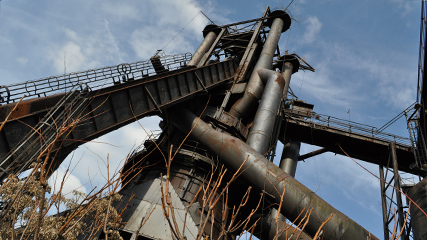
Since U.S. Steel halted operations at the Carrie Furnace in 1978, nature moved in. Trees tangle their way through the plant, and grapevines crisscross the catwalks. Ben Muessig for AOL News
The abandoned steel mill has become a destination for graffiti artists, paintball players, vagrants and vandals who strip the site and sell the stolen scrap metal.
“The wiring and anything else that can be scrapped has been taken out,” said Emig, who told AOL News she’s often chased away uninvited visitors. “With the graffiti, the paint wears off. It’s the people who are physically stripping the site who are the problem.”
Rivers of Steel plans to restore some parts of the Carrie Furnace to look the way they did when the plant was operational. But other parts — like a massive sculpture of a deer head built from metal and wire in the 1990s by the Industrial Arts Co-Op — will remain as they are today.
“We will preserve some of the graffiti, definitely the deer,” Emig said. “This site didn’t die in 1978. This place continued to be used, and we want to show that.”
Even if Rivers of Steel gets its wish and is able to preserve the remaining steel mill structures, the rest of the 168-acre property could look very different in the coming years. Allegheny County owns the entire site and began renting the Carrie Furnace buildings to Rivers of Steel in May.
County officials are looking for builders interested in bringing light manufacturing and residential development to the rest of the grassy plot.
New businesses or homes near the old steel mill will certainly change the site’s context, but they won’t compromise the Carrie Furnace as a historic site, according to Emig.
“It’s already compromised,” she said. “There’s only two furnaces left; there used to be seven. You work with what you have.”
The most important thing the Carrie Furnace has is its historic site, according to Arthur Ziegler, president of the Pittsburgh History and Landmarks Foundation.
“We have saved artifacts from the mills — blowing engines, a Bessemer converter and so forth — but we had to relocate them,” Ziegler said. “But this will be the first time it’s all preserved on site.”
Obviously, making the dilapidated steel mill a safe destination for sightseers isn’t going to be easy — or cheap.
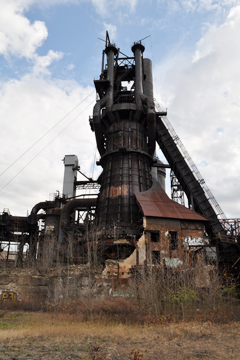
Turning the decaying steel mill into a park and history center won't be cheap -- but preservationists say residents of the "Steel City" are rallying behind their plan. Ben Muessig for AOL News
The group’s “bare-bones cost estimate” for the project is $78 million. Current funding only allows for repairs of a severely damaged roof at one of the powerhouses.
To fund other projects, like securing shaky catwalks, clearing out tons of debris from the mill’s stock house, or perhaps building a monorail like the one depicted in flashy conceptual images of the historic center, the group will seek public funding and private donations.
There’s talk of approaching the National Parks Service for help, but it’s unclear whether the cash-strapped agency would be interested in or able to offer assistance.
Though finances are a concern, Moreira says she’s been encouraged by the interest in the project.
“Heritage matters,” said Moreira, whose group has given tours of the Carrie Furnace to more than 700 eager visitors in the past two months. “It’s not only important to know where we come from, but it’s important looking to the future.”
In the years since the steel industry left Pittsburgh, the “Steel City” has in many ways attempted to distance itself from its metal-producing past. But the city’s industrial legacy lives on — and not just in the name of its football team and local beer.
According to Moreira, many Pittsburghers have started looking to the city’s steel-making roots as a source of pride.
“There was a lot of bitterness when the steel went away. People wanted to move on. But now people are at the point where they want to look back,” she said.
“This isn’t just steel; it’s about emotions.”
-
Pitt Class to Nominate Bloomfield School for Historic Registry
By Adam Brandolph
PITTSBURGH TRIBUNE-REVIEW
Monday, December 13, 2010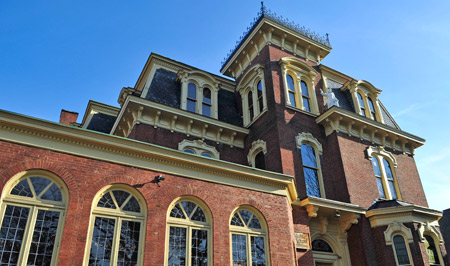
The Ursuline Academy (dates back to 1894), a Catholic girls school, opened in its Bloomfield location in 1894 and closed in 1981. In 1993, the building was sold, restored and named Victoria Hall, a venue for weddings and celebrations. The Waldorf School bought the property in 2003. Sidney Davis | Pittsburgh Tribune-Review
The ornate wood and plaster work inside the former Ursuline Academy in Bloomfield has been around for about 140 years.
A nomination to the National Register of Historic Places next month could ensure it lasts at least twice as long.
The building on South Winebiddle Street near the borders of Friendship Park, Garfield and Lawrenceville has been a hands-on laboratory for University of Pittsburgh students learning how to research historic buildings. The students will release their findings to the public at 7 p.m. Tuesday in the building’s auditorium.
The class plans to present the nomination to the Pennsylvania Historical and Museum Commission in January. If approved, the commission would send it to the National Park Service in Washington for a final review.
Officials with the building’s current tenant, the Waldorf School, a private school for students in kindergarten through fifth grade, applaud the efforts.
“It’s a wonderful place to have a school,” said Alexandra Gruskos, Waldorf’s board president and an attorney for the Allegheny County Office of Children, Youth and Families. “We’re very happy about the nomination.”
Students in Jeff Slack’s documentation and conservation studio course pored over historic maps, photographs, deeds and building permits in researching the history of the 21-room mansion built for Henry J. Lynch in the late 1860s.
“The nomination is the result of the ongoing work begun in 2008 by Pitt preservation students that included a detailed evaluation of the physical condition of the building,” Slack, a historic preservation planner at Pfaffmann + Associates, PC, Downtown, said in a written statement.
“But this year, the students’ work focuses more so on research that shows the far-reaching educational contributions of the Ursuline Academy to the local community.”
The historic designation would prevent federal money from being used to alter the building, said Brendan Froeschl, facilities manager for the Waldorf School. The building was well-preserved because it was turned into a school after initially being a residence, he said.
“The Ursulines did a wonderful job. When you come in the front door, you’re in the front door of the original mansion,” Froeschl said.
Dan Holland, director of the Young Preservationists Association of Pittsburgh, said other buildings across the city would benefit from the expertise of the class.
“To do this kind of work is a huge help,” Holland said.
The Ursuline Academy, a Catholic girls school, opened in its Bloomfield location in 1894 and closed in 1981. In 1993, the building was sold, restored and named Victoria Hall, a venue for weddings and celebrations. The Waldorf School bought the property in 2003.
-
Hotel Saxonburg Chef Returns to Recently Renovated Landmark
By Pam Starr, FOR THE PITTSBURGH TRIBUNE-REVIEW
Sunday, December 12, 2010
Hotel Saxonburg's executive chef, Alan Green, and owner, Judy Ferree, with Penne Carbonara Erica Hilliard | Valley News Dispatch
Judy Ferree loved Hotel Saxonburg so much as a customer that she decided to buy the Butler County landmark in July.
The former owner, Domenic Gentile, had died a few years ago, and his wife realized she couldn’t keep the restaurant going, says Ferree, a resident of Middlesex.
“I thought this would be a good project,” says Ferree, 50, who used to own Lakevue Athletic Club with her husband, Bob, and managed Butler Country Club for a number of years. “I had watched it slide, partly due to the economy, but I wanted to get Hotel Saxonburg back to where it was.”
Ferree closed the place for five weeks for needed renovation. All of the kitchen equipment was replaced, including the refrigeration units and ventilation system, and the entire interior was painted. The original tin ceiling in the dining room was repaired and painted.
But Ferree was careful to keep the old-fashioned charm and elegance that Hotel Saxonburg is known for. Hotel Saxonburg was built in 1832 and is listed in the National Registry of Historic Places. The black-and-white checkered floor tile is still intact, and the copper-topped bar dates to the 19th century. Five upstairs sleeping rooms have been meticulously refurbished to reflect the 1800s. Ferree points out that Woodrow Wilson once stayed there.
The 138-seat Hotel Saxonburg is the oldest continually operating restaurant and bar in Butler County, she says.
“We reopened on Aug. 12, and it’s been exciting,” she says. “It’s livened up the whole community. I brought back the chef, Alan Green, who was here for 18 years and left to work at the Springfield Grill for four years. He’s the heart of the place and is so approachable and humble. He’ll be the first one to jump in and help the dishwasher.”
Green, 55, has been cooking professionally for 35 years and hand-picked the culinary team when he returned. The Aliquippa native began his career while a student at Penn State, where he graduated with a Spanish degree.
“I cooked my way through school, and my knowledge of Spanish was invaluable while working as a chef in Washington, D.C.,” he says. “When I hire someone, the first thing I look for is enthusiasm, and the ability to look me in the eye. They also need to be able to take criticism.”
Green is very pleased with the chefs and cooks who work with him at Hotel Saxonburg.
“I have some young guns here that are terrifically talented but need steady guidance,” says Green, who is married and lives in Butler. “I can’t marathon anymore at my age, so I teach. I also try to learn something every day.”
The American menu is Green’s creation. He wanted to return to the classics, he says, as well as keep up with trends. His appetizers include staples such as crab cakes, fried asparagus and shrimp cocktail. But one will also find zucchini cakes with roasted red pepper sauce; ground beef sliders; Crimini mushrooms filled with clam stuffing and topped with bacon; and grilled New Zealand lamb chops.
Hotel Saxonburg is famous for its lobster bisque, and Green wouldn’t dream of taking that off the menu. Entrees feature classics such as filet mignon, baby back ribs, chicken gorgonzola and seafood pasta. Green includes other items like sauteed black sea bass filets; satay fire-grilled chicken skewers with wild mushrooms and marinara sauce; shrimp tempura with sweet Thai chile sauce; and cucumber-crusted salmon filet with a cucumber-wasabi puree.
Everything on the menu is made from scratch, he says.
“We get our seafood from Curtze Foods in Erie, and some from Pittsburgh Seafood,” Green says. “Our chicken, lamb and beef comes from Curtze, and US Foods. Our specialty products are from Thoma’s, right down the road, and their pork is superior. Perriello Produce in Natrona Heights handles our produce. They’re all good guys.”
The hours are the hardest part of being a chef, he says, but the “happy stuff far outweighs the dark stuff.” Writing cookbooks is on Green’s bucket list, and the first one will be about soups.
“All I do is think about food,” he says with a laugh. “I read food, I study food, I watch food. Cooking is very rewarding. When you get one customer who tells you how nice their dinner was, it makes your month.”
Penne Carbonara

Chef Alan Green is sharing is popular Penne Carbonara recipe. He uses local bacon from Thoma's to give the dish more oomph, and uses an egg in the final phase to thicken the dish. Erica Hilliard | Valley News Dispatch
Chef Alan Green is sharing is popular penne carbonara recipe. He uses local bacon from Thoma’s to give the dish more oomph, and uses an egg in the final phase to thicken the dish.
“The egg is a delicious way to enhance and enrich the flavor,” says Green. “The sauce should be just thick enough to coat the noodles. This is a good, wintery pasta dish that fills you up.”
He suggests serving this hearty meal with whatever wine you enjoy.
- 3 tablespoons clarified butter
- 2 tablespoons red onion, julienned
- 1 teaspoon minced garlic
- 1/4 cup thick-sliced bacon, diced
- Salt and freshly ground black pepper, to taste
- 1/2 cup heavy cream
- 12 ounces cooked penne pasta
- 1/4 cup grated Romano cheese
- 1 large egg
- 2 tablespoons chopped parsley
Put the butter, red onion, garlic and bacon in a saute pan over medium-high heat. Sweat the onion and garlic for about 2 minutes, and season with salt and pepper.
Add the heavy cream and bring to a boil. Reduce the heat and simmer until reduced by half.
Cook the pasta according to package directions, and drain well. Add the cooked pasta to the cream mixture and season again with salt and pepper. Add the Romano cheese, and then remove from the heat. Stir in the egg and mix well.
Place the pasta in a serving bowl, sprinkle with chopped parsley, and serve immediately.
Makes 2 servings.
Hotel Saxonburg:Cuisine: American
Hours: 11 a.m.-10 p.m. Tuesdays-Thursdays, 11 a.m.-11 p.m. Fridays and Saturdays, 11 a.m.-9 p.m. Sundays
Entree price range: $10-$23
Notes: Major credit cards accepted. Handicapped accessible. Reservations recommended for weekends. Bottles of wine for $15 featured on Tuesdays and Thursdays. Sunday brunch. Five hotel rooms upstairs.
Address: 220 Main St., Saxonburg, Butler County
Details: 724-352-4200 or website
-
Public Gets Hands-On With Ideas for South Park Fairgrounds
Thursday, December 09, 2010By Margaret SmyklaThe public put its money where its mouth was during a public meeting last week about the future of the South Park Fairgrounds.
Everyone in the audience was given $500 in fake money to play a kind of board game, placing the “money” on an element that the player thought was a priority.
Elements receiving heavy play included removing Schoonmaker Hall, improving the oval fields/track surfaces and enhancing the park gateways.
A popular write-in item was “improving bathrooms.”
The input from this meeting, as well as another public meeting in September and focus groups and an online survey will be incorporated into a report from GAI Consultants, of Homestead, that is planned for completion at month’s end.
The study is supported by the Richard King Mellon Foundation, the Heinz Endowments and the county.
While there is no money in hand for improvements, the county is more likely to receive funding from foundations, and the state and federal governments, if a plan is in place, said county parks director Andy Baechle. There is no timetable.
The process was set in motion through a master plan created several years ago for all nine county parks. One of its recommendations was the formation of a nonprofit parks foundation to which tax-deductible donations could be made.
That done, the master plan was again addressed, such as its call for a detailed vision of the 76 county-owned acres from Corrigan Drive to McCorkle Road encompassing the Fairgrounds, exhibit hall buildings, amphitheater, police barracks, Nature Center, tennis/basketball courts, and more.
“This area has a tons of potential, but it has lagged,” said Jeaneen Zappa, the Allegheny County’s sustainability manager.
At the meeting, three options — titled “Modified,” “Campus” and “Picturesque” — were presented to solicit comments from the audience.
The “Modified” option is based on what can be done fairly easily and economically, such as removing/repairing bleachers, improving oval fields/track surfaces and enhancing park gateways.
With “Campus,” which emphasizes pedestrians, the recommendations include removing Agricultural Hall for additional parking, adding a “green” parking lot at McCorkle and Brownsville roads and reclaiming the southern end of Catfish Run.
“Picturesque” focuses on the naturalistic quality of the park’s original planning, such as reconfiguring the oval track to curvilinear shape, relocating the tennis/basketball courts and relocating the nature center adjacent to Catfish Run.
Ms. Zappa said the final report will likely include elements of all three,
Christine Fuller, executive director of the Allegheny County Parks Foundation, said the organization will review the final report and work with the county on the next steps.
After the meeting, Jeff Danchik, director of the Mon Valley Express, a drum and bugle corps which leases space from the county at Brownsville Road and Corrigan Drive, said the area needs more attractions, such as a craft shows or flea markets.
“A lot of people don’t know we’re here,” Mr. Danchik said.
Walt Sackinsky of South Park said he would like to see the infrastructure addressed, such as aging water, gas, and sewer lines, and fire hydrants.
For Terry Tressler of South Park, priorities include improvements to Corrigan Drive such as adding a middle turning lane with room on each side of the road for walkers and bikers.
His wife, Donna Tressler, would like to see Schoonmaker Hall, which is used for storage, razed. “It is falling down and dangerous, with kids going in and out,” she said.
A big priority for both is improving the bathrooms.
The couple, lifetime park users, are hopeful for change after attending both public meetings.
“I’m impressed with the caliber of people who seem to want to improve the park,” he said.
-
Rachel Carson Homestead Association Board of Directors Opens Search for New Executive Director
December 2, 2010
PRESS RELEASE:
Contact:
Bill Schillinger 724-321-7915bill@rachelcarsonhomestead.org
New Era Begins for Regional Environmental Organization
SPRINGDALE, PA – (Dec. 2, 2010) – The Board of Directors of the Rachel Carson Homestead Association, a regional organization dedicated to the principles of greater environmental awareness and action promoted by its namesake, announced today the opening of a search for a new executive director.
Following a thorough strategic planning process, the not-for-profit organization has embarked on a program to restore and transform the childhood home of Rachel Carson in Springdale, Pennsylvania, just north of Pittsburgh, into a center for information and ideas on a healthy environment. Coordinating a capital campaign in support of this transformation will be a major responsibility of the new executive director.
The Association takes it inspiration from Carson, a professional marine biologist who achieved international fame in 1962 for her groundbreaking book, “Silent Spring,” which discussed the potential hazards of synthetic pesticides. The Association plans a series of special events to commemorate the 50th anniversary of “Silent Spring” in 2012.
“Rachel Carson stood for strong principles like integrity, open dialogue, and fostering a positive exchange of ideas concerning the environment,” said William Schillinger, chairman of the Rachel Carson Homestead Association board. “Our organization stands for those same principles. With the start of our search for a new executive director, we intend to increase efforts to make the Homestead a destination site. It is the primary focus of our group’s mission.”
The executive director will be responsible for the day-to-day administration of the organization,along with fund-raising and
other publicly-oriented activities. The search follows the departure of Patricia DeMarco, PhD., who, as executive director of the Homestead Association for the past five years, has been instrumental in growing its programs.“As we move forward, we are ready to engage new leadership that will manage the Capital Campaign and events surrounding the Homestead’s renewal in 2012,” said Schillinger. “Much like the impressive span over the Allegheny River that bears Rachel Carson’s name, we will continue to build strong bridges focused on active, respectful, dialogue about the challenging environmental issues of our day.” he said.

